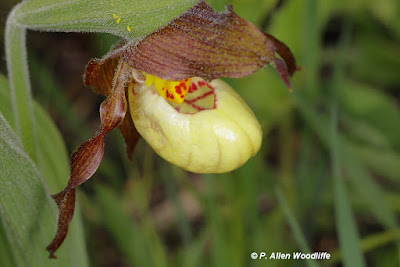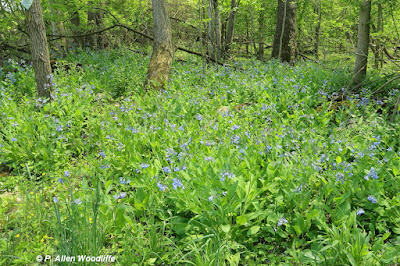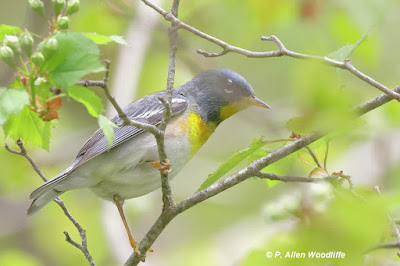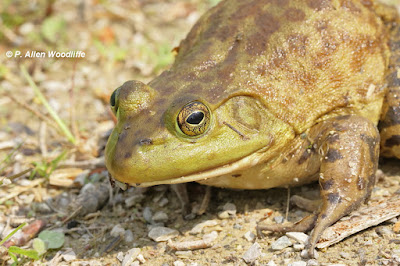A few days ago I decided to forego any serious birding activities, as this is also the time of year when some of the rarest, most threatened and endangered plants can be found, but it takes some planning.
One of the rarest plant species is an orchid, the Small White Ladies'-slipper (Cypripedium candidum). It formerly grew in small number of widely scattered places in Ontario, but currently it only occurs in an area of eastern Ontario, and on the incredible prairies of Walpole Island First Nation. Due to my working relationship with the folks at WIFN, I have been privileged to have seen them there on a number of occasions from about the mid 1980s until the early 2000s. However I had not seen them for quite awhile, so made contact with someone I have worked with over the last couple of decades or more, and made arrangements to check them out. We ventured to one of the largest and most remote prairies, and bingo, found a couple of dozen or more.
The photos above show pure examples of this endangered orchid. What is even more intriguing in some ways, is that it may hybridize with the Small Yellow Ladies'-slipper ( Cypripedium parviflorum). Finding some of the variable hybrids is always rewarding. These next photos show the variability in their colour, and are known as Andrew's Lady-slipper (Cypripedium X andrewsii). As you can see, they are not pure white or pure yellow, but may vary. Their sepals are typically more purplish than those of the Small White's as well.
There were other plants of interest on this prairie, but I didn't spend a lot of time with them. This first photo shows a small portion of this phenomenal prairie, much of which was burned this late winter or early spring, creating great conditions for tallgrass prairie. In the first photo, in the middle range, there are quite a few small yellow flowers.
...unlike this next one, the smallish Yellow Star Grass (Hypoxis hirsuta) which is also endangered, as it is found in less than half a dozen places in Ontario.
I had other rarities to catch up to on this day, and since I was more or less going by the Sydenham River Nature Reserve, owned by Ontario Nature, decided to stop in and see how the Virginia Bluebells (Mertensia virginica) were doing there. I had seen a fantastic display of them a week or so earlier, in Elgin County, but hadn't seen this population on the Lambton/Middlesex border for a couple of years.
They weren't quite as spectacular as in some years. Whether it was due to unusual water levels, or the way the spring unfolded as some of them seemed to show being hit with a touch of frost, or something else. I didn't get to the most impressive part of the site which is not easy to get to. However I was able to enjoy quite a few clusters and individuals throughout part of their normal range here.
They bloom prolifically for a relatively short period, but are likely 95% finished by now.
I left the SRNR and headed to my next target area, to see another endangered species. It was in Middlesex County, in the Strathroy area, and the species to check up on was Drooping Trillium (Trillium flexipes). In Canada, it is only found in Middlesex County, with a possibility of a population in neighboring Elgin.
I hadn't seen this population for about 14 years, and wasn't certain I could find it, if it still existed. But persistence, and a reasonable memory, of its location proved to work, and I found about 15 plants. It droops more than other Trillium species....
I was pleased to find that at least some individuals remained, and had I taken more time to explore, may have found others.
On the way home, I stopped at a couple of places in the Skunk's Misery and Thamesville area, where I expected to find good flowering populations of yet another endangered species, although much more widespread across southwestern Ontario than the other species featured here. It is Eastern Flowering Dogwood (Cornus florida), a largish shrub that can get to small tree size on occasion. These first two photos were taken from the roadside, so I didn't have to go far.
The flowers themselves can vary somewhat in appearance, as the next two photos show. They will have bright red berries when the fruits are ripe later in the summer.
Another endangered species is one that many years ago, was planted in a small prairie patch. It is Moss Phlox, (Phlox subulata) and likes open sandy situations, flowering right at ground level.
So there you have it: a variety of rare, threatened and endangered species that even keen botanists seldom see. These are just a small sample of the incredible diversity of rare flora here in southwestern Ontario!
If you would like to subscribe, or unsubscribe, to Nature Nuggets, send an email to: prairietramper@gmail.com








































































